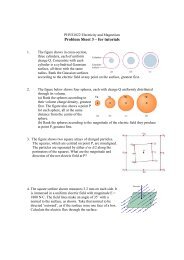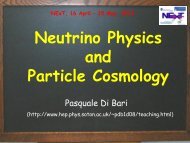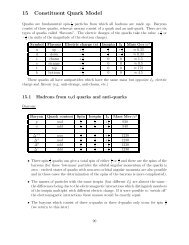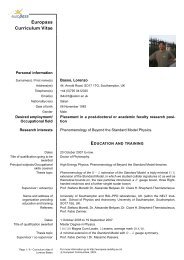Slides in PDF format - hep
Slides in PDF format - hep
Slides in PDF format - hep
You also want an ePaper? Increase the reach of your titles
YUMPU automatically turns print PDFs into web optimized ePapers that Google loves.
dark energy<br />
phenomenology<br />
Mart<strong>in</strong> Kunz<br />
University of Sussex<br />
ma<strong>in</strong>ly with Luca Amendola and Domenico Sapone
Outl<strong>in</strong>e<br />
• State of the nation: w(z)<br />
– And ask questions at any time<br />
– Please slow me down if needed!!<br />
• Why go beyond w?<br />
– Because we need to / we do it already<br />
– Because we learn more<br />
• The future<br />
• Conclusions
how much vacuum energy?<br />
Let us count the energy density <strong>in</strong> the<br />
universe:<br />
(Ω X<br />
=ρ X<br />
/ρ c<br />
=8πGρ X<br />
/(3H 02<br />
))<br />
- radiation: CMB-temp ⇒ Ω γ<br />
≈ 5x10 -5<br />
too small to matter…<br />
comb<strong>in</strong>e SN-Ia and CMB distance<br />
measurements:<br />
- matter: Ω m<br />
≈ 0.3<br />
(whereof baryons ≈ 0.05! [BBN/CMB])<br />
-cosmological const.: Ω Λ<br />
≈ 0.7<br />
(and space is close to flat)
what is the problem with Λ?<br />
log ρ<br />
radiation (~1/a 4 )<br />
matter<br />
(~1/a 3 )<br />
Let’s guess the size of the<br />
contribution by Λ:<br />
• QM contribution ~ k 4 .<br />
• Planck cutoff: Λ ≈ 10 76 GeV 4<br />
• measured: Λ ≈ 10 -47 GeV 4<br />
• worst prediction ever?<br />
cosmological<br />
constant (~constant)<br />
log a<br />
imag<strong>in</strong>ation<br />
dom<strong>in</strong>ated<br />
radiation<br />
dom<strong>in</strong>ated<br />
matter<br />
dom<strong>in</strong>ated<br />
Lambda<br />
dom<strong>in</strong>ated<br />
p=wρ
homogeneous dark energy<br />
Assume that the universe is perfectly homogeneous and isotropic<br />
(and flat): FLRW metric<br />
T µν<br />
must be:<br />
ds 2 = dt 2 - a(t) 2 dr 2<br />
E<strong>in</strong>ste<strong>in</strong>:<br />
H 2 =<br />
probed by<br />
distance<br />
measurements<br />
matter: p = 0 -> ρ ~ a -3<br />
radiation: p = ρ/3 -> ρ ~ a -4<br />
dark energy: p = ? (< -ρ/3)<br />
(def<strong>in</strong>e w = p/ρ)<br />
-> the only th<strong>in</strong>g to measure<br />
is w(z) or H(z) / a(t)
distances <strong>in</strong> the universe<br />
( 1+z = a 0<br />
/a )<br />
standard ruler<br />
(CMB peak, BAO, …)<br />
D<br />
standard candle<br />
(supernova)<br />
r<br />
r
(current) qu<strong>in</strong>tessence results<br />
WMAP-3yr + SNLS-1yr limits:<br />
• scalar field model<br />
[ c s2<br />
=1, σ=0]<br />
• regularised transition of w=-1<br />
• uses “k<strong>in</strong>k” model for w(z)<br />
• cosmological constant fits well<br />
• strong constra<strong>in</strong>ts only at low-z<br />
• dark energy becomes subdom<strong>in</strong>ant<br />
<strong>in</strong> the past<br />
excluded<br />
95% confidence<br />
region<br />
MK & D. Sapone, PRD 74, 123503 (2006)<br />
B.A. Bassett, P.S. Corasaniti & MK, ApJL 617, L1 (2004)<br />
P.S. Corasaniti, MK, D. Park<strong>in</strong>son, E.J. Copeland & B.A. Bassett, PRD 70, 083006 (2004);<br />
MK, P.S. Corasaniti, D. Park<strong>in</strong>son & E.J. Copeland, PRD 70, 041301R (2004);<br />
B.A. Bassett, MK, D. Park<strong>in</strong>son & C. Ungarelli, PRD 68, 043504 (2003);<br />
B.A. Bassett, MK, J. Silk & C. Ungarelli, MNRAS 336, 1217 (2002) + diverse proceed<strong>in</strong>gs
Short summary<br />
• Flat LCDM good fit to data<br />
• -0.7
measur<strong>in</strong>g dark th<strong>in</strong>gs<br />
E<strong>in</strong>ste<strong>in</strong>:<br />
(<strong>in</strong> cosmology)<br />
(determ<strong>in</strong>ed by the<br />
metric)<br />
geometry<br />
stuff<br />
(what is it?)<br />
your favourite theory<br />
someth<strong>in</strong>g<br />
Cosmologists observe the<br />
geometry of space time<br />
someth<strong>in</strong>g<br />
else<br />
This depends on the total<br />
energy momentum tensor<br />
That is what we measure!
In our m<strong>in</strong>ds, dark matter and<br />
dark energy are neatly<br />
separated concepts.<br />
hot<br />
cold<br />
But <strong>in</strong> reality we can only observed their<br />
comb<strong>in</strong>ed effect.<br />
If we can adjust the temperature and<br />
flow of the hot water, we can vary the<br />
flow of the cold water without chang<strong>in</strong>g<br />
the total flow or the total temperature.
What do you th<strong>in</strong>k?<br />
Do we understand the dark energy?<br />
YES<br />
NO<br />
Do you believe that <strong>in</strong> a flat universe Ω m<br />
≈ 0.2 - 0.4?<br />
YES<br />
NO
The true value of Ω m<br />
is…
the dark degeneracy<br />
How well do we know Ω m<br />
<strong>in</strong> general (flat) DE models?<br />
Different question: given H(z), what is w(z)?<br />
We get a solution for any Ω m<br />
!<br />
impossible to measure simultaneously w(z) and Ω m<br />
only total dark energy-momentum tensor is measurable<br />
good test for generality of a parametrisation…
perturbations are important!<br />
Only a cosmological constant has no perturbations<br />
c s2<br />
=0<br />
c s2<br />
=1<br />
Λ<br />
c s2<br />
=1<br />
(c s<br />
2<br />
> 1 , X = (∇φ) 2 , also DBI, f(R)? )<br />
M.Kunz, astro-ph/0702615, arXiv:0710.5712
Where are we (go<strong>in</strong>g)?<br />
• Whether we can measure Ω m<br />
depends<br />
decisively on the DE perturbations<br />
• So what def<strong>in</strong>es the properties of the DE<br />
perturbations?<br />
• Are modified gravity models different?<br />
• Notice a very strong degeneracy between<br />
smooth DE and curvature: what is Ω K<br />
?<br />
(exercise: can you break this degeneracy?)
measur<strong>in</strong>g the dark side<br />
small perturbations: extended metric<br />
φ, ψ gravitational potentials δρ and V perturbations of T µν<br />
E<strong>in</strong>ste<strong>in</strong> eqs.<br />
fluid properties<br />
measure total w, δp, σ !<br />
δp = c s<br />
2<br />
δρ <strong>in</strong> DE rest frame<br />
σ (anisotropic stress, φ =ψ for σ=0)<br />
(and compare with predictions)<br />
(alternatively, measure φ and ψ: weak lens<strong>in</strong>g (WL) measures φ+ψ,<br />
while peculiar velocities / redshift space distortions measure ψ alone)
equations<br />
metric:<br />
conservation equations (for each fluid <strong>in</strong>dependently)<br />
(vars: δ=δρ/ρ, V ~ divergence of velocity field, δp , σ anisotropic stress)<br />
E<strong>in</strong>ste<strong>in</strong> equations (common, may be modified if not GR)<br />
(Bardeen 1980)
What do you th<strong>in</strong>k?<br />
Can we dist<strong>in</strong>guish dark energy from<br />
modified gravity and rule out GR<br />
by measur<strong>in</strong>g the growth-rate?<br />
YES<br />
NO<br />
it depends
dark gravity vs dark energy<br />
• DGP: brane-world model<br />
without dark energy<br />
• scalar field: high sound speed<br />
prevents DE cluster<strong>in</strong>g<br />
• the perturbations <strong>in</strong> the dark<br />
energy can perturb the dark<br />
matter<br />
• and mimic models of modified<br />
gravity<br />
• σ = 0 kills DGP, S/T, f(R)<br />
• σ ≠ 0 kills scalar field DE<br />
-> we can test such models!<br />
-> but we cannot rule out GR<br />
dark matter pert. growth rate δ m<br />
/a<br />
σ<br />
δp<br />
scalar field<br />
DGP<br />
MK & D. Sapone, PRL 98, 121301 (2007)
The general argument<br />
modified “E<strong>in</strong>ste<strong>in</strong>” eq: X µν<br />
= -8πGT µν<br />
(e.g. projection to 3+1D from higher-D scenario)<br />
Y µν<br />
can be seen as an effective DE energy-momentum<br />
tensor.<br />
Is it conserved?<br />
Yes, s<strong>in</strong>ce T µν<br />
is conserved, and s<strong>in</strong>ce G µν<br />
obeys the Bianchi<br />
identities!<br />
There is also no place “to hide”, s<strong>in</strong>ce T µν<br />
is also derived<br />
from a general symmetric tensor.
ug or feature?<br />
• bug:<br />
– cannot directly test GR<br />
• feature:<br />
– strong clues <strong>in</strong> result + need theory anyway<br />
– clear target for what should be measured<br />
– <strong>in</strong>dependent of whether MG or DE is<br />
realised<br />
it’s a feature!
dark energy phenomenology<br />
• Perturbations are an essential part of many<br />
cosmological measurements<br />
• If we “ignore” them, we are effectively just<br />
choos<strong>in</strong>g someth<strong>in</strong>g without be<strong>in</strong>g aware of it<br />
• Results do strongly depend on that choice<br />
• Observationally, they can be characterised by two<br />
(possibly effective) additional functions,<br />
<strong>in</strong>dependently of the mechanism that generates<br />
the accelerated expansion<br />
• Models make specific predictions for the<br />
perturbations – much more so than for w(z)!
How can we measure it?<br />
• w(z) from SN-Ia, BAO directly (and conta<strong>in</strong>ed <strong>in</strong><br />
most other probes)<br />
• Curvature from radial & transverse BAO<br />
• In addition 5 quantities, e.g. φ, ψ, bias, δ m<br />
, V m<br />
• Could even skip DM, we cannot see it (yet)<br />
• Need 3 probes (s<strong>in</strong>ce 2 cons eq for DM)<br />
• e.g. 3 power spectra: lens<strong>in</strong>g, galaxy, velocity<br />
• Lens<strong>in</strong>g probes φ + ψ<br />
• Velocity probes ψ (z-space distortions?)<br />
• And galaxy P(k) then gives bias (reqd for z-dist)<br />
→ Euclid / JDEM can do it all!
weak lens<strong>in</strong>g forecasts [DUNE]<br />
different nonl<strong>in</strong>ear<br />
mapp<strong>in</strong>gs<br />
lens<strong>in</strong>g potential:<br />
not just φ!<br />
don’t<br />
forget!<br />
4πGa 2 ρ m<br />
∆ m<br />
but ∆ m<br />
is also affected directly! [with γ=γ(Q,η)]<br />
qu<strong>in</strong>tessence<br />
DGP<br />
Σ = Q (1+η/2) ~ 1+O(0.1)<br />
• these are very optimistic plots<br />
• weak lens<strong>in</strong>g has uncerta<strong>in</strong> systematics<br />
• and requires l<strong>in</strong>ear -> non-l<strong>in</strong>ear mapp<strong>in</strong>g<br />
• very powerful if it works!<br />
L. Amendola, MK and D. Sapone, JCAP 04, 013 (2008)
future experiments<br />
• CMB: parameters, ISW; Planck, ground (SZ/B-pol)<br />
• SN-Ia: w(z); lots (FEADEP*, ground † )<br />
– low-z : normalisation, probe of local universe<br />
– perturbations, “lum<strong>in</strong>osity tomography”<br />
– theoretical & statistical advances (reduce dispersion)<br />
• BAO: w(z); SDSS, WFMOS, photo † , FEADEP, Ly-α (z ≤ 3)<br />
– complementary to SN-Ia (mostly l<strong>in</strong>ear physics, different)<br />
– can <strong>in</strong> pr<strong>in</strong>ciple measure evolution of curvature<br />
• weak lens<strong>in</strong>g: φ+ψ [not DM!]; FEADEP, ground †<br />
• galaxy surveys: growth rate, φ; SDSS, WFMOS, FEADEP<br />
• peculiar velocities: ψ; redshift space distortions?<br />
• LHC / dark matter searches: p<strong>in</strong> down DM, theory<br />
†<br />
e.g. FMOS, DES, darkCAM, Pan-STARRS [~2009] / LSST, SKA [2014+]<br />
* Future European American Dark Energy Probe [~2017+]
f<strong>in</strong>al summary<br />
• still no really good theoretical model …<br />
Λ fits all obs.<br />
• cosmology can (and will!) measure just a few<br />
functions, e.g. w(z), φ(k,z), ψ(k,z)<br />
• good (clear target for observations) and bad (no<br />
unique identification of physical mechanism)<br />
• requires multiple probes, e.g. weak lens<strong>in</strong>g +<br />
galaxy surveys + supernovae<br />
• control of systematics will be crucial as effects<br />
are very small!<br />
• but the data is only just beg<strong>in</strong>n<strong>in</strong>g to pour <strong>in</strong>!









